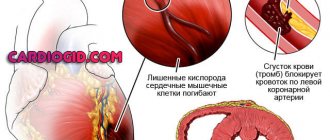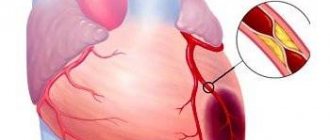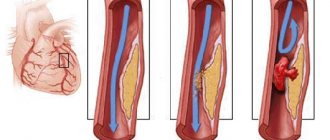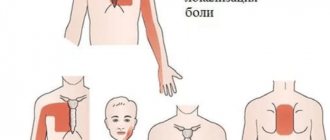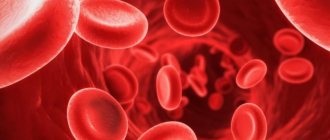What is a heart attack?
The term myocardial infarction defines a pathological process, the consequence of which is the death of a section of cardiac muscle tissue due to a sharp disruption of blood circulation against the background of the influence of several provoking factors:
- Coronary heart disease, which is the result of cholesterol deposition in the coronary arteries supplying the myocardium.
- Hypertension with a prolonged increase in systemic blood pressure.
- Thrombophlebitis is an inflammatory process in the venous vessels, accompanied by the formation of blood clots, which can subsequently clog the coronary arteries.
- Age and gender of the person – often pathology can occur in men over 50 years of age. In women, the pathological process usually develops with the appearance of severe pain.
- Smoking and systematic drinking of alcohol, indulgence in fatty foods, which contribute to faster deposition of cholesterol in the arteries.
- Insufficient physical activity of a person.
- Frequent and severe emotional or physical stress.
- A change in the functional state of the blood, accompanied by increased coagulability and intravascular thrombus formation.
In order to avoid the development of a heart attack, it is important to exclude exposure to all provoking factors, which is possible through lifestyle modifications.
Effective treatments
A myocardial infarction suffered in the legs is treated in a hospital with medications that dissolve blood clots and restore adequate blood flow in the main cardiac artery.
The doctors' task is to administer a drug that dissolves the clot as early as possible. The best option is the first hour, its second name is “golden”. Next, injections are given that reduce the intensity of blood circulation. This helps reduce the oxygen demand of the heart muscle and increase the viability of starved cells in the affected area.
To “predict” the formation of a new blood clot, injections are used that reduce blood clotting. If necessary, surgery is performed.
Is it possible to miss a heart attack?
Insufficient nutrition of the heart muscle and tissue death are usually accompanied by the development of severe pain, which initially has the character of compression, and then sharply intensifies.
A heart attack can go unnoticed; a painless form of the pathological process develops in several situations:
- Individual characteristics of the human body, which include a high pain sensitivity threshold, as well as certain anatomical changes in the innervation of the heart muscle.
- A long course of coronary heart disease, in which there is a gradual “adaptation” of sensitive receptors, as well as the central structures of the nervous system, to pain sensations.
- Taking certain medications that have the ability to reduce the severity of pain - non-steroidal or hormonal anti-inflammatory drugs, sedatives.
- Exhaustion of a person, in which the activity of the nervous system, including the afferent part responsible for sensitivity, decreases.
- A small focus of a pathological process called a microinfarction. On the legs, the disease can be transmitted frequently; it is detected after a long time due to the identification of formed connective tissue scars in the area of tissue death.
Knowledge of provoking factors will allow one to suspect the possible development of the disease, especially in the case of general, nonspecific symptoms.
Symptoms
Asymptomatic or hidden infarction is characterized by the absence of the main manifestation – compressive or severe pain in the chest area behind the sternum. Signs of changes in the functional state of the cardiovascular system may often appear, which include:
- Pronounced sweating or the appearance of “cold sweat”.
- Nausea, often accompanied by vomiting.
- Marked feeling of weakness.
- Drowsiness, which can reach significant severity, even to the point of fainting.
- The appearance of sensations of numbness, which predominantly radiate to the left side.
- Decrease in systemic blood pressure (arterial hypotension).
A person may associate the appearance of general symptoms with overwork and insufficient sleep. The fact that a heart attack is occurring without heart pain may be indicated by several characteristic features that you should pay attention to:
- The appearance of unmotivated weakness several weeks before a heart attack.
- General signs of changes in the functional state of the cardiovascular and autonomic nervous systems are characterized by constancy, more often appear in the evening, and they lead to the development of insomnia.
- There is an increase in the clinical symptoms of “silent” heart attack after physical or emotional stress.
- As signs of a heart attack develop, shortness of breath of varying severity appears.
- With a long course of the pathological process, especially against the background of damage to a significant volume of tissue, the development of consequences is not uncommon.
If a person has suffered a heart attack without severe symptoms and in the absence of complications, then he may not know about it for a long time. Typically, the pathological condition is detected retrospectively on an ECG in the form of formed connective tissue scars.
Important! A fairly common sign of a “silent” heart attack is the sudden appearance of an acute human reaction to various odors.
Preventive measures
People who have the following abnormalities may be at risk for patients:
- Diabetes.
- High blood pressure.
- Obesity.
- Elderly age.
- Having suffered severe psychological trauma in the past.
To avoid a heart attack, you should lead a healthy lifestyle, quit smoking and drinking alcohol, and balance your daily menu. Also, people at risk need to control their blood pressure; to do this, it must be measured daily and, if necessary, take medications.
Physical activity should be reduced and replaced with something easier, in addition, work should be alternated with rest. Come up with a daily routine for yourself in which work, rest and eating will be carried out at the same time every day.
Try to drink at least two liters of water a day, add seafood, goat's milk cheese to your diet, and replace animal fats with vegetable oil. You can even take the Mediterranean diet as a basis.
It is necessary to completely get rid of alcohol and tobacco addiction. If possible, avoid stressful situations so that your emotional state is at peace, and try to receive more positive emotions.
Is a “silent” heart attack dangerous?
If a person manages to suffer a small tissue infarction, then acute complications often do not develop. In the area of dead cells, a connective tissue scar gradually forms.
If a significant amount of tissue is damaged, a heart attack can lead to the development of several dangerous complications:
- Decreased myocardial contractility with the development of acute or chronic heart failure.
- The development of arrhythmia, which is characterized by a change in the rhythm and speed of heart contractions.
- Thrombosis is the formation of blood clots inside the cavities of the heart in the area of dead (necrotic tissue).
- The formation of a large connective tissue scar (cardiosclerosis), which causes deformation of the valves and insufficiency of their functional state.
- Partial rupture of the heart wall in the area of tissue death, which is a very dangerous condition, as blood leaks into the pericardium. This causes compression (tamponade) of the heart with subsequent cardiac arrest.
- The development of pulmonary edema caused by acute disruption of the contractile function of the heart.
One of the criteria for a heart attack “on the legs” is that it brings an exacerbation of other diseases of the cardiovascular system, in particular hypertension and pericarditis.
Important! The danger of a rupture of the heart wall is that it can develop a long time after a heart attack at the stage of formation of a connective tissue scar.
Consequences
The consequences of a heart attack suffered on the legs can be life-threatening for the patient. Ischemic damage to heart tissue creates conditions for the formation of blood clots. Blood clots can travel through the bloodstream, causing pulmonary embolism, damage to the kidneys, brain and other organs.
In addition, a heart attack suffered in the legs can result in death within a few days. A fatal outcome is often observed if tissue rupture occurs against the background of heart damage due to the ischemic process. Cardiogenic shock often develops against the background of rupture of myocardial tissue. This condition is accompanied by a sharp drop in blood pressure, shortness of breath and other symptoms.
Heart rhythm disturbances of varying severity are a common consequence of a heart attack. In addition, pulmonary edema may occur, which is accompanied by increasing respiratory failure and can cause death.
Against the background of such a pathological condition as a heart attack, the formation of an aneurysm is often observed in the future. This defect occurs when the formed scar begins to stretch under intracardiac pressure. This complication is characterized by progressive heart failure, because the efforts of the muscles of the organ do not allow blood to be completely ejected from the expanded cavity.
Myocardial infarction suffered on the legs can create conditions for the development of cardiosclerosis, which is accompanied by the replacement of healthy areas of the heart with fibrous tissue. This leads to progressive heart failure.
How to identify?
Reliable detection of a previous heart attack with minimal clinical manifestations is possible using objective diagnostic techniques, which include:
- ECG - cardiogram is a functional research method that makes it possible to determine the nature and location of ischemia (insufficient tissue nutrition) or myocardial infarction.
- “Holter” monitoring is the recording of a cardiogram using a portable device for a long period of time (usually about a day), during which the patient leads a normal lifestyle.
- Echocardioscopy is an ultrasound examination of the heart, which makes it possible to visualize affected tissue. It will show the severity of the pathological process, as well as its localization.
- Biochemical blood test - determination of the activity of certain enzymes in the plasma, which increases with the death of a large number of myocardial cells (myocardiocytes).
- A clinical blood test is the determination of a number of indicators that make it possible to assess the functional state of many organs and systems, as well as to identify the inflammatory process that often develops against the background of a heart attack.
If necessary, the doctor prescribes other research methods that help establish or exclude the presence of complications, as well as other concomitant pathologies.
Timely diagnosis of a heart attack suffered “on your feet” is an important measure that helps prevent the development of complications and negative health consequences.

